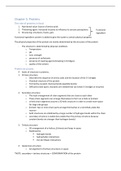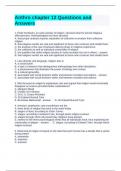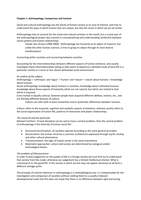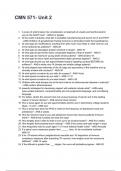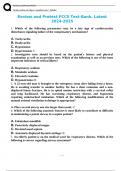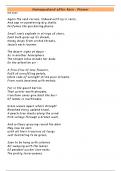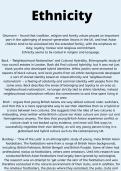Chapter 5: Proteins
The role of proteins in food
1. Nutritional value: Source of amino acids
2. Thickening agent: Increased viscosity to influence its sensory perceptions Functional
3. Structuring: emulsions, foams, gels ingredient
Functional ingredient: protein is added to give the system a certain physical property
The physical properties of the protein are mainly determined by the structure of the protein
- The structure is determined by physical conditions
o Temperature
o pH
o ionic strength
o presence of surfactants
o presence of reacting agents (breaking S-S bridges)
o quality of the solvent
Protein structures
4 levels of structure in proteins;
1. Primary structure
o Describes the sequence of amino acids and the location of the S-S bridges
o Chemical structure of the protein
o Formed by covalent chemical bonds (peptide bonds)
o Difficult to take apart, reactants are needed that can break S-S bridges or enzymes
2. Secondary structure
o The local arrangement of chain segments that are close to each other
o These chain segments can arrange themselves to form an α-helix or β-sheet
o α-helix chain segments assume a 3D helix structure in order to create more space
for large side groups
o β-sheet: two or more chain parts arrange themselves in a stretched, plate-like
manner
o both structures are stabilized by a large number of hydrogen bonds within the chain
o secondary structure is stable (less stable than the primary structure because
covalent bonds are stronger than hydrogen bonds)
3. Tertiary structure
o 3D arrangement of α-helices, β-sheets and loops in space
o Stabilized by
hydrogen bonds
hydrophobic interactions
Van der Waals interactions
4. Quaternary structure
o Arrangement of tertiary structures in space
*NOTE: secondary + tertiary structures = CONFORMATION of the protein
, Classification of proteins based on conformation
Distinguish two types of proteins (in order of decreasing complexity)
1. Globular proteins
2. Random coil proteins
Globular proteins
- Rich in secondary and tertiary structures
- Folded into a compact, spherical shape with hydrophobic amino acid residues in the core
and hydrophilic residues with polar groups and charges located on the outer layer creating a
hydrophilic shell
- Because they are compact they show very little swelling in water and therefore when
dissolved as monomers give only a small increase in viscosity
o Not very effective thickening agents
- Examples: Ovalbumin, β-lactoglobulin
- Globular proteins of high molecule weights often fold themselves into chains of several
spheres
- To make a stable solution of a globular protein, the individual molecules must be dispersed
in the solvent
- A solution of a globular protein is a colloidal system and can therefore the stability can be
described using the DLVO theory
- The interaction potential of two dissolved globular proteins is given by;
𝑉𝑇𝑂𝑇 = 𝑉𝐴𝑇𝑇 + 𝑉𝑅𝐸𝑃
For native globular proteins attractive forces are mainly determined by Van
der Waals interactions
Other contributions to attractive forces are from hydrophobic interactions,
hydrogen bonding, Sulphur and salt bridges
Repulsion is mainly determined by electrostatic repulsion and Born
repulsion
Electrostatic repulsion is a result of the charges in the outer “shell” of the
globular protein
- The strength of the electrostatic repulsion depends on the surface potential of the globular
proteins and the Debye length (the thickness of the diffuse double layer)
o The surface potential mainly determined by the pH of solution
o Debye length is determined by the salt concentration/ionic strength
The role of proteins in food
1. Nutritional value: Source of amino acids
2. Thickening agent: Increased viscosity to influence its sensory perceptions Functional
3. Structuring: emulsions, foams, gels ingredient
Functional ingredient: protein is added to give the system a certain physical property
The physical properties of the protein are mainly determined by the structure of the protein
- The structure is determined by physical conditions
o Temperature
o pH
o ionic strength
o presence of surfactants
o presence of reacting agents (breaking S-S bridges)
o quality of the solvent
Protein structures
4 levels of structure in proteins;
1. Primary structure
o Describes the sequence of amino acids and the location of the S-S bridges
o Chemical structure of the protein
o Formed by covalent chemical bonds (peptide bonds)
o Difficult to take apart, reactants are needed that can break S-S bridges or enzymes
2. Secondary structure
o The local arrangement of chain segments that are close to each other
o These chain segments can arrange themselves to form an α-helix or β-sheet
o α-helix chain segments assume a 3D helix structure in order to create more space
for large side groups
o β-sheet: two or more chain parts arrange themselves in a stretched, plate-like
manner
o both structures are stabilized by a large number of hydrogen bonds within the chain
o secondary structure is stable (less stable than the primary structure because
covalent bonds are stronger than hydrogen bonds)
3. Tertiary structure
o 3D arrangement of α-helices, β-sheets and loops in space
o Stabilized by
hydrogen bonds
hydrophobic interactions
Van der Waals interactions
4. Quaternary structure
o Arrangement of tertiary structures in space
*NOTE: secondary + tertiary structures = CONFORMATION of the protein
, Classification of proteins based on conformation
Distinguish two types of proteins (in order of decreasing complexity)
1. Globular proteins
2. Random coil proteins
Globular proteins
- Rich in secondary and tertiary structures
- Folded into a compact, spherical shape with hydrophobic amino acid residues in the core
and hydrophilic residues with polar groups and charges located on the outer layer creating a
hydrophilic shell
- Because they are compact they show very little swelling in water and therefore when
dissolved as monomers give only a small increase in viscosity
o Not very effective thickening agents
- Examples: Ovalbumin, β-lactoglobulin
- Globular proteins of high molecule weights often fold themselves into chains of several
spheres
- To make a stable solution of a globular protein, the individual molecules must be dispersed
in the solvent
- A solution of a globular protein is a colloidal system and can therefore the stability can be
described using the DLVO theory
- The interaction potential of two dissolved globular proteins is given by;
𝑉𝑇𝑂𝑇 = 𝑉𝐴𝑇𝑇 + 𝑉𝑅𝐸𝑃
For native globular proteins attractive forces are mainly determined by Van
der Waals interactions
Other contributions to attractive forces are from hydrophobic interactions,
hydrogen bonding, Sulphur and salt bridges
Repulsion is mainly determined by electrostatic repulsion and Born
repulsion
Electrostatic repulsion is a result of the charges in the outer “shell” of the
globular protein
- The strength of the electrostatic repulsion depends on the surface potential of the globular
proteins and the Debye length (the thickness of the diffuse double layer)
o The surface potential mainly determined by the pH of solution
o Debye length is determined by the salt concentration/ionic strength

